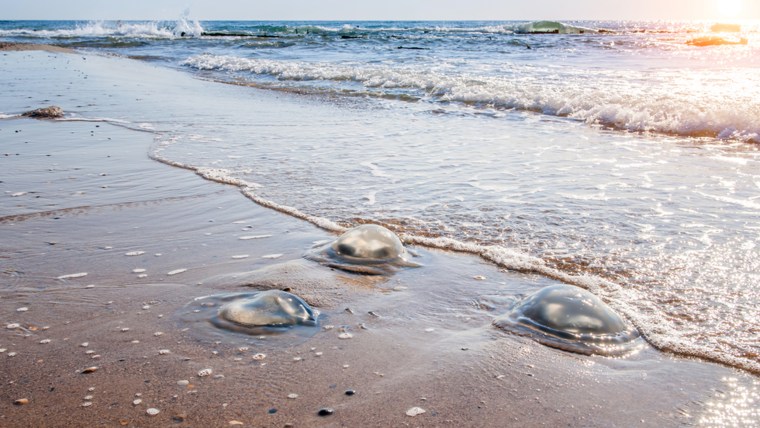The last thing anyone wants at a day at the beach is stress, health problems or worse. Unfortunately that's what some beach goers in Florida got when they went for a dip.
Lifeguards in Pensacola reported on Tuesday mild cases of "sea lice," also referred to as seabather's eruption, which causes rashes, welts and could lead to flu-like symptoms in severe cases.

Cases of this pesky reaction caused by jellyfish have been reported along 250 miles of Florida's southern Atlantic coastline for more than a century, according to the Florida Department of Health.
Here's how to protect yourself from sea lice, along with other potential beach dangers, including riptides, jellyfish, sand flees, riptides and even sharks:
1. Sea lice
The summer months are peak time for the health condition many refer to as sea lice.
Sea lice are the larvae of the thimble jellyfish: small, clear and brown jellyfish about the size of a thimble. Jellyfish travel in packs, making it easy for swimmers to spot and avoid them. But the larvae are tiny, resembling a dot — making them difficult to see. They can get trapped in swim suits, hair and T-shirts worn into the water resulting in an itchy rash.
Local authorities at beaches in Florida use purple flags to alert swimmers about sea lice, but because sea lice float with the tides, one beach might experience an outbreak while another remains unaffected.
People who think they’ve encountered sea lice should:
- Shower
- Wash the bathing suit with hot water and detergent to kill the organisms
- Take an antihistamine
- Use topical itch relief cream
2. Jellyfish
Almost everyone who's ever swam in an ocean knows that uncomfortable sting caused by jellyfish, translucent sea creatures with long tentacles found in oceans around the world. The good thing is that you can see jellyfish, as they float instead of swim, so just moving away helps.
If stung, you should:
- Remove tentacles from your skin
- Rub saltwater over the affected area to remove microscopic stinging cells (freshwater agitates stinging cells)
The American Red Cross updated its recommendations for jellyfish stings, according to Dr. Peter G. Wernicki, a member of the organization's scientific advisory council. He urged people to avoid other methods they may have heard of in the past like using vinegar, urine or ice to minimize the pain.
“Heat is the best thing for relieving the pain and discomfort,” Dr. Wernicki said in a 2016 interview.
3. Rip currents
About 80 percent of all lifeguard rescues occur because swimmers find themselves in rip currents, which pulls people away from shore, said Tom Gill, public information officer for the U.S. Lifesaving Association.
“If they are non-swimmers they are going to go under or people will fight that rip current and go under,” Gill said in a 2016 interview. “It is very easy for panic to set in.”
In the water, it’s tough to see rip currents and they’re even hard to detect from the beach. They look like murky, debris-filled, foamy water, which might be lighter on the sides and darker in the middle. Often they're near sandbars or jetties.
If caught in a rip current, swimmers should:
- Stay calm, panicking will only tire you out
- Signal to lifeguards for help
- Swim parallel with the shore (don't try to swim toward the beach)
“If you go parallel to the shore you can get out,” Wernicki explained. “If you try to swim directly back in (to the shore), the current is too strong.” The number one piece of advice? Swim at a beach with lifeguards
“If you swim at a guarded beach, your drowning risk is one in 18 million,” Wernicki said.
Following these common-sense tips can help keep swimmers safe:
- Swim in groups
- Don’t drink alcohol
- Stay hydrated
- Don’t dive into waves
- Keep children within arm’s length
- Wear a Coast Guard approved life jacket if you are a poor swimmer
4. Sharks
The chances of being bitten by a shark are ridiculously low, according to Christopher Lowe, director of the California State University Long Beach Shark Laboratory. Last year, there were 88 unprovoked shark attacks. Normally, sharks avoid swimming close to the shore, but sometimes their patterns change.
As unlikely as a shark attack is, there are ways to avoid them:
- Don't swim near seals (or other animals that are shark food)
- Swim in groups
- Avoid swimming at dawn and dusk (more fish are in the water at these times and the predators take advantage of this)
5. Sand fleas
Sand fleas — which are actually small crabs — live in the sand and love biting ankles, feet and legs. These bites turn into small, red itchy welts.
“It's another irritation, but won't cause major damage,” Gill said.
It doesn’t seem that bug sprays prevent the bites. If people suspect they have sand flea bites, he recommends they clean off the area and treat them as they would bug bites, with an over-the-counter cortisone cream or an oral antihistamine.
Don't let these ocean critters ruin your vacation! Keep these tips in mind for a safe and healthy summer vacation.
